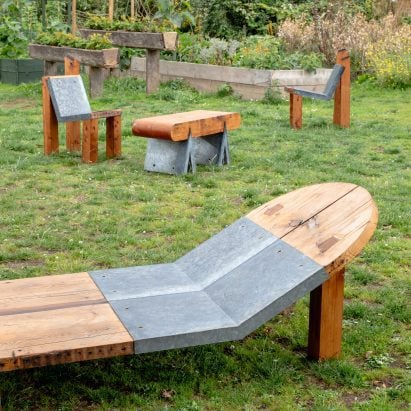WWW.DEZEEN.COM
Adrienne Lau creates Acute and Obtuse outdoor furniture from salvaged materials
Architect Adrienne Lau combined steel parts from old planters with beams from a demolished army barrack to create chairs and benches for a food-growing community in east London.Acute and Obtuse is a series of outdoor furniture developed by Lau for Abbey Gardens, an open-access park and harvest garden in Newham.The furniture was entirely made from reclaimed materials, including a collection of raised beds installed 15 years ago following the formation of the community garden.Adrienne Lau has created an outdoor furniture series made from reclaimed materialsThe trapezoidal planters were constructed from wooden boards and fastened by galvanised steel corner sleeves, but over time they had begun to deteriorate and were in need of replacement.The beds were dismantled by local volunteers and members of the Abbey Gardens community, who identified the potential for them to be reused.Lau allowed the materials to steer the outcomes, with the shapes of the galvanised steel brackets informing the configurations of the various seating solutions."The specific angles of the steel corners lend themselves well to forming the structure of different furniture types 150 degrees for a lounger, 110 degrees for a chair, and the smaller angles as supports for benches," explained Lau.Lau repurposed old wooden planters fastened by galvanised steel corner sleevesOnce the steel sections were unbolted from the wood boards, it was necessary for Lau to find new ways of forming joints due to the toxicity and risk of welding the thin galvanised metal.The steel sleeves were combined with sections of Douglas fir beams and pine joists that were reclaimed from a demolished Victorian army barracks by designer and maker Rosie Strickland, who provided technical design and fabrication support on the project.The angles of the steel corners inspired the furniture's configurationsLau and Strickland developed furniture forms that optimise the shapes of the angular inserts. Several of the designs feature rounded shapes that contrast with the angular steel.The salvaged timber sections display evidence of their past use, with notches and nail holes left exposed and untreated to add character to the furniture.Read: Dutch Invertuals chair remixed by Kiki van Eijk, Daphna Laurens and moreMortise and tenon joints were used to attach simple, square-profiled legs to the seating surfaces. The visible fixings contribute to the overall approach of celebrating the furniture's materiality and production processes.According to Lau, the project demonstrates how waste materials can be reused to create new objects that evoke the Japanese concept of wabi-sabi, where flaws and signs of ageing are intrinsic to the outcome.Several designs feature rounded forms that contrast with the angular steel"Instead of hiding them, imperfections should be embraced creatively to make material reuse more widely desirable," Lau explained."Making the collective material story evident inspires people to take good care of it," she added. "After all, objects are kept from waste when they are valued."Simple square legs are joined to seats with mortise and tenon jointsThe Acute and Obtuse furniture formed part of a larger project called Let's Meet On The Edge developed by Lau and her partners at Edgy Collective for the 2023 edition of the London Festival of Architecture.As one of three nature-based installations that linked disconnected green spaces around Edgware in north London, the outdoor furniture was installed in the High Street to encourage residents to experience their local area in new ways. The project won the Community Prize at the New London Awards 2024.Following the festival's conclusion, the furniture was relocated to Abbey Gardens where the steel corners originated from. The pieces provide flexible seating for the garden community and customers at Spring Cafe.The notches and nail holes were left untreated to add character to the furnitureAs part of Edgy Collective, Lau works with Leila Taheri on projects aimed at revitalising urban spaces by reconnecting them with natural, cultural histories and present day realities.Her personal practice focuses on addressing social and ecological concerns by applying creative solutions to projects spanning architecture, furniture design, urban installations and scenography.Other recent Dezeen stories featuring chairs include 14 designers and studios reimagining a Dutch Invertuals chair and a furniture collection crafted from reclaimed spruce and oak.The photography is by Raquel Diniz.The post Adrienne Lau creates Acute and Obtuse outdoor furniture from salvaged materials appeared first on Dezeen.
